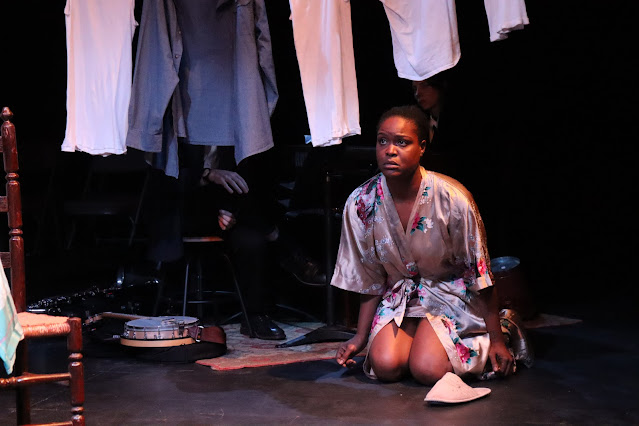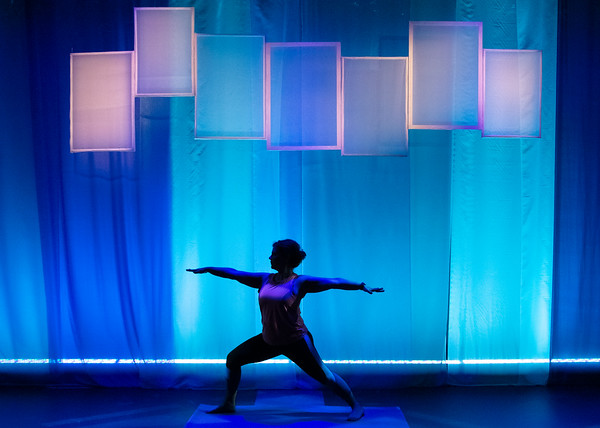Outraged Hearts: The Pretty Trap and Interior: Panic
Written by Tennessee Williams
Directed by Jaclyn Bethany
22 E 30th Street, Manhattan, NYC
May 15-30, 2025
 |
| L to R: Chris Ghaffari, Jaclyn Bethany, Jacob Storms, Megan Metrikin. Photo by Joey D'Amore. |
Tennessee Williams's (1911-1983)
The Glass Menagerie (1944) and
A Streetcar Named Desire (1947) have long since secured a central place in the pantheon of 20th-century American theater. Their single-act precursors, however,
The Pretty Trap (1944?) and
Interior: Panic (1945-46), remain far less widely known and produced. Under the title Outraged Hearts, New Orleans-based theater company The Fire Weeds, founded by Jaclyn Bethany and Lin Gathright and "dedicated to innovative storytelling through a female-driven lens," fruitfully juxtaposes these underseen one-acts in a theatrical double bill that frames strong, character-driven performances with vivid visual choices.
 |
| Jacob Storms and Jaclyn Bethany. Photo by Geve Penaflor. |
Outraged Hearts divides itself into two acts, of which
The Pretty Trap–described by Terrence McNally as "an embryonic
Glass Menagerie" in his foreword to
Tennessee Williams: One Act Plays (Methuen Drama, 2011)–is the first. Before the play proper begins, against an aural backdrop of moody strings, Jaclyn Bethany's Laura Wingfield, clad in a white dress with a blue flower alluding to
The Glass Menagerie's version of Laura being referred to as "Blue Roses," repeatedly circles the perimeter of the set, which has seating on three sides and semitransparent curtains around its entirety, a perpetual outsider. Her mother, Amanda (Megan Metrikin), wearing her own white dress, is fuzzily visible within; and her opening dialogue is heard in voiceover, with the actors switching to live delivery at Laura's first line, further aligning the presentation with her perspective. It is only when Laura's brother, Tom (Chris Ghaffari), and his coworker Jim Delaney (
Jacob Storms) arrive, visitors from the world outside the Wingfield home, that the curtains are opened on three sides (leaving the rear curtain to delineate, here and in
Interior: Panic, a space that is simultaneously offstage and onstage).
 |
| Chris Ghaffari. Photo by Geve Penaflor. |
Tom and Jim work in a warehouse, but Tom (Williams's own birth name) wants to be a writer, while Jim has his own larger aspirations. As for Laura, Amanda asserts that the only path forward for her daughter is marriage, even though Laura would prefer to "be left alone" and live by herself with her collection of glass animals. Jim's visit is part of Amanda's plan to make a marriage happen, although she, "a perennial southern belle," as Tom says, can't resist flirting herself, with Metrikin immediately sitting knee-to-knee with Storms on a quite small settee. Further complicating Amanda's attempt to set up her daughter, and drawing on the potential echoes of Williams in Tom, this production adds strong suggestions, both in how Tom puts his hand on Jim's shoulder and in how Tom reacts to Amanda telling him (in this version, incorrectly) that Jim kissed Laura, that Tom likes Jim as more than just a friend. In addition to shifting the agency to Laura in the would-be kiss, the production ties shifts in perspective (and lighting) to her, prompted by a snap of her fingers. Bethany's Laura is often awkward, shying away from eye contact, at other times displaying a childlike directness, and even once, in a nice detail, mouthing her mother's lines, indicating just how often she has heard this all before. Metrikin lends power to Amanda's extreme swings in mood, while Ghaffari gives the dreamer Tom a veneer of coolness which he then proceeds to break and Storms renders Jim as fundamentally kind and empathetic if repeatedly surprised by the Wingfield women. McNally's foreword notes the absence in
The Pretty Trap of the "framing device" of "Tom's narratives and his extraordinary language" that appears in
The Glass Menagerie, but this production gestures towards such a frame with an added coda that deftly emphasizes both the sibling bond and Tom's echoes of Williams.
 |
| Lauren Guglielmello. Photo by Joey D'Amore |
For
Interior: Panic, we move from the lamps and chaises and Victrola of the Wingfield home to the less genteel poverty of the camp bed, ironing board, and bare wood furniture of the Kiefaber residence, where pregnant Grace (Lauren Guglielmello) lives with her husband, Jack (Chris Ghaffari). Staying with them is Grace's sister, Blanche Shannon (Jaclyn Bethany), who has been forced by accusations of immoral behavior at her place of employment to impose on her sister's hospitality even though, as Bethany embodies her, she delivers "Kiefaber" like an insult every time that she says it. Like the Wingfields lost Amanda's husband, who left them and disappeared, Blanche has lost her suitor, George, while she still longs for the also lost (and portentously named) Shannon family home, Belle Reve. This Blanche, like the DuBois incarnation, struggles with her mental health, and the production effectively shifts us into her paranoid internal monologue by bathing the performance area in red and, in one excellent section, having Jack's voice appear to issue from a female bill collector (Sarah Schuler) as she and Grace circle one another with animal intensity.
.jpg) |
| L to R: Sarah Schuler and Lauren Guglielmello. Photo by Joey D'Amore. |
Bethany's playing both Laura and Blanche, as well as the color-coded lighting changes, blue for one, red for the other, that indicate alignment with their perspectives, invite us to notice the parallels between these (entrapped) women, the one as perhaps a darker variation on the other. Within this play, Ghaffari's doubling of Jack and another role invite similar comparison. McNally writes that "the full-length [Streetcar] is presaged in Blanche's reveries," and after some early shouting involving Jack, who leaves to go bowling, these reveries build to Blanche's revelation of the abovementioned accusation, of how she behaved after losing Belle Reve (which involved a familial death), and her (again, paranoid) theory of why George hasn't come around lately. Jack may be, per McNally, as much "Blanche's victim as her predator" in Interior: Panic, but Ghaffari also plays him with a volatility that matches that of Bethany's Blanche and recalls Streetcar's Stanley. Bethany's hands sometimes visibly shake as Blanche, highlighted by her almost always holding a cigarette, but she also ably balances Blanche's angry, distrustful side with a more vulnerably confessional Blanche as she opens up to Grace, whom Guglielmello compellingly plays as negotiating the line between compassion for and standing up to her unwell (and increasingly unwelcome) sister. McNally sees "hope at the end, faint yet surely there, for Blanche," Bethany's striking delivery of Blanche's final lines position this hope as faint indeed.
 |
Jaclyn Bethany. Photo by Joey D'Amore.
|
One might view the curtains of Outraged Hearts' set design as perhaps also hinting at the gauzy recesses of the mind, and the creative decisions in this production only enhance the psychological and perceptual portraits that it delivers. If the short plays that Outraged Hearts comprises offer different ways to look at two of Williams's more canonical works, this production also offers an excitingly fresh view of those one-acts themselves.
-John R. Ziegler and Leah Richards




.jpg)




Comments
Post a Comment